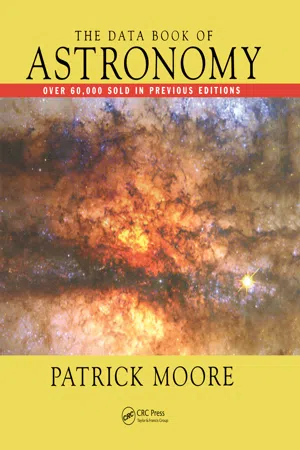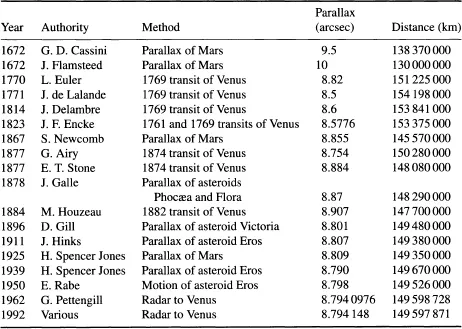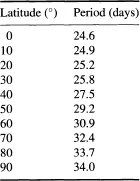
This is a test
- 340 pages
- English
- ePUB (mobile friendly)
- Available on iOS & Android
eBook - ePub
The Data Book of Astronomy
Book details
Book preview
Table of contents
Citations
About This Book
Filled with data about the Earth, Moon, the planets, the stars, our Galaxy, and the myriad galaxies in deep space, this invaluable resource reveals the latest scientific discoveries about black holes, quasars, and the origins of the Universe. It includes maps supported by detailed tables of the names, positions, magnitudes, and spectra of the main stars in each constellation along with key data on galaxies, nebulae, and clusters. MNASSA wrote, "This book fills a niche with detailed astronomical data and concise explanations, all at an accessible level it is an excellent resource, and probably will be the first book I shall reach for.
Frequently asked questions
At the moment all of our mobile-responsive ePub books are available to download via the app. Most of our PDFs are also available to download and we're working on making the final remaining ones downloadable now. Learn more here.
Both plans give you full access to the library and all of Perlego’s features. The only differences are the price and subscription period: With the annual plan you’ll save around 30% compared to 12 months on the monthly plan.
We are an online textbook subscription service, where you can get access to an entire online library for less than the price of a single book per month. With over 1 million books across 1000+ topics, we’ve got you covered! Learn more here.
Look out for the read-aloud symbol on your next book to see if you can listen to it. The read-aloud tool reads text aloud for you, highlighting the text as it is being read. You can pause it, speed it up and slow it down. Learn more here.
Yes, you can access The Data Book of Astronomy by Patrick Moore in PDF and/or ePUB format, as well as other popular books in Ciencias físicas & Astronomía y astrofísica. We have over one million books available in our catalogue for you to explore.
Information
1 THE SOLAR SYSTEM
The Solar System consists of one star (the Sun), the nine principal planets, their satellites and lesser bodies such as asteroids, comets and meteoroids, plus a vast amount of thinly-spread interplanetary matter. The Sun contains more than 99% of the mass of the system, and Jupiter is more massive than all the other planets combined. The centre of gravity of the Solar System lies just outside the surface of the Sun, due mainly to the mass of Jupiter.
The Solar System is divided into two parts. There are four relatively small, rocky planets (Mercury, Venus, the Earth and Mars), beyond which come the asteroids, of which only one (Ceres) is over 900 km in diameter. Next come the four giants (Jupiter, Saturn, Uranus and Neptune), plus Pluto, which is smaller than our Moon and has an unusual orbit which brings it at times closer in than Neptune. Pluto may not be worthy of true planetary status, and may be only the largest member of the ‘Kuiper Belt’ swarm of asteroidalsized bodies moving in the far reaches of the Solar System. However, Pluto does seem to be in a class of its own, and in size is intermediate between the smallest principal planet (Mercury) and the largest asteroid (Ceres). Planetary data are given in Table 1.1.
It now seems that the distinctions between the various classes of bodies in the Solar System are less clear-cut than has been previously thought. For example, it is quite probable that some ‘near-Earth asteroids’, which swing away from the main swarm, are ex-comets which have lost their volatiles; and some of the smaller satellites of the giant planets are almost certainly ex-members of the asteroid belt which were captured long ago.
All planets and asteroids move round the Sun in the same sense, and so do the larger satellites in orbit round their primary planets, although some of the small asteroidal-sized satellites have retrograde motion (for example, the four outer members of Jupiter’s family and Phœbe in Saturn’s). The orbits of the main planets are not greatly inclined to that of the Earth, apart from Pluto (17°), so that to draw a plan of the planetary system on a flat piece of paper is not grossly inaccurate. However, some asteroids have highly-inclined orbits, and so do many comets. It is now thought that short-period comets, all of which have direct motion, come from the Kuiper Belt, while long-period comets, many of which move in a retrograde sense, come from the more distant Oort Cloud.
Most of the planets rotate in the same sense as the Earth, but Venus and Pluto have retrograde rotation, while Uranus is unique in having an axial inclination which is greater than a right angle. The cause of these anomalies is unclear.
ORIGIN OF THE SOLAR SYSTEM
In investigating the origin of the planetary system we do have one important piece of information: the age of the Earth is certainly of the order of 4.6 thousand million1 years and the Sun, in some form, must obviously be rather older than this. Meteorites are, in general, found to be of about the same age, while the oldest lunar rocks are only slightly younger.
Many theories have been proposed. In 1796 the French astronomer Pierre Simon de Laplace put forward the Nebular Hypothesis, which was in some ways not unlike earlier ideas due to Thomas Wright in England and Immanuel Kant in Germany, but was much more credible. Laplace started with a vast gas cloud, disk-shaped and in slow rotation, which shrank steadily and threw off rings, each of which condensed into a planet, while the central part of the cloud became the Sun. However, it was found that a ring of this sort would not condense into a planet. Moreover, according to the Nebular Hypothesis, most of the angular momentum of the Solar System would reside in the Sun, which would be in quick rotation; actually, most of the angular momentum is due to the giant planets.
Table 1.1. Basic data for the planetary system. The orbital data for the planets change slightly from one revolution to another.

In 1901 T. C. Chamberlin and F. R. Moulton, in America, worked out a theory according to which the planets were pulled off the Sun by the action of a passing star; a cigar-shaped tongue of material would be pulled out and this would break up into planets, with the largest planets (Jupiter and Saturn) in the middle part of the system, where the thickest part of the ‘cigar’ would have been. Again there were insuperable mathematical objections, and a modification of the theory by A. W. Bickerton (New Zealand), involving a ‘partial impact’, was no better. The original theory was popularized by Sir James Jeans during the first half of the 20th century, but it has now been abandoned. If it had been valid, planetary systems would have been very rare in the Galaxy; close encounters between two stars seldom occur.
Later, G. P. Kuiper proposed that the Sun had a binary companion which never condensed into a proper star, but was spread around to produce planet-forming material; but again there were mathematical objections, and the theory never met with wide support.
Modern theories are much more akin to Laplace’s than to later proposals. It is thought that the Solar System began in a huge gas-and-dust cloud, part of which started to collapse and to rotate – possibly triggered off by the effects of a distant supernova. A ‘solar nebula’ was produced, and in a relatively short period, perhaps 100000 years, the core turned into what may be called a protostar, the effects of which forced the solar nebula into a flattened, rotating disk. The temperature rose at the centre, and the proto-Sun became a true star; for a while it went through what is known as the T Tauri stage, sending out a strong ‘stellar wind’ which forced outward the lightest gases, notably hydrogen and helium. The planets built up by accretion. The inner, rocky planets lacked the lightest materials, while in the more distant regions, where the temperature was much lower, the giant planets could form. Jupiter and Saturn grew rapidly enough to draw in material from the solar nebula; Uranus and Neptune, slower to form, could not do so in the same way, because by the time they had become sufficiently massive the nebula had more or less dispersed. This is why Uranus and Neptune contain lesser amounts of hydrogen and helium and more ‘ices’. Nuclear processes began in the Sun, and the Solar System began to assume its present form, although at first the Sun was less luminous than it is now.
In its early stages there was a great deal of material which did not condense into planetary form, and the planets were subjected to heavy bombardment, resulting in impact cratering. The main bombardment ended around 4000 million years ago, but the effects of it are still very obvious, as can be seen from the structures visible on the surfaces of the rocky bodies (see Table 1.2).
At present the Solar System is essentially stable, and will remain so until the Sun leaves the Main Sequence and becomes a giant star. This will certainly result in the destruction of the inner planets, so that the Solar System as we know it does have a limited life-span.
Table 1.2. Descriptive terms for surface features.

1 I avoid using ‘billion’, because the American billion (now generally accepted) is equal to a thousand million, while the old English billion was equal to a million million.
2 THE SUN
The Sun, the controlling body of the Solar System, is the only star close enough to be studied in detail. It is 270 000 times closer than the nearest stars beyond the Solar System, those of the Alpha Centauri group. Data are given in Table 2.1.
Table 2.1. The Sun: data.

DISTANCE
The first known estimate of the distance of the Sun was made by the Greek philosopher Anaxagoras (500–428 BC). He assumed the Earth to be flat, and gave the Sun’s distance as 6500 km (using modern units), with a diameter of over 50 km. A much better estimate was made by Aristarchus of Samos, around 270 BC. His value, derived from observations of the angle between the Sun and the exact half-moon, was approximately 4800 000 km; his method was perfectly sound in theory, but the necessary measurements could not be made with sufficient accuracy. (Aristarchus also held the belief that the Sun, not the Earth, is the centre of the planetary system.) Ptolemy (c AD 150) increased the distance to 8000 000 km, but in his book published in AD 1543 Copernicus reverted to only 3200 000 km. Kepler, in 1618, gave a value of 22 500 000 km.
The first reasonably accurate estimate of the Earth–Sun distance (the astronomical unit) was made in 1672 by G. D. Cassini, from observations of the parallax of Mars. Some later determinations are given in Table 2.2.
One early method involved transits of Venus across the face of the Sun, as suggested by J. Gregory in 1663 and extended by Edmond Halley in 1678; Halley rightly concluded that transits of Mercury could not give accurate results because of the smallness of the planet’s disk. In fact, the transit of Venus method was affected by the ‘Black Drop’ –the apparent effect of Venus drawing a strip of blackness after it during ingress on to the solar disk, thus making precise timings difficult. (Captain Cook’s famous voyage, during which he discovered Australia, was made in order to take the astronomer C. Green to a suitable site (Tahiti) in order to observe the transit of 1769.)
Results from the transits of Venus in 1874 and 1882 were still unsatisfactory, and better estimates came from the parallax measurements of planets and (particularly) asteroids. However, Spencer Jones’ value as derived from the close approach of the asteroid Eros in 1931 was too high. The modern method – radar to Venus – was introduced in the early 1960s by astronomers in the United States. The present accepted value of the astronomical unit is accurate to a tiny fraction of 1%.
Table 2.2. Selected estimates of the length of the astronomical unit.

ROTATION
The first comments about the Sun’s rotation were made by Galileo, following his observations of sunspots from 1610. He gave a value of rather less than one month.
The discovery that the Sun shows differential rotation – i.e. that it does not rotate as a solid body would do – was made by the English amateur Richard Carrington in 1863; the rotational period at the equator is much shorter than that at the poles. Synodic rotation periods for features at various heliographic latitudes are given in Table 2.3. Spots are never seen either at the poles or exactly on the equator, but from 1871 H. C. Vogel introduced the method of measuring the solar rotation by observing the Doppler shifts at opposite limbs of the Sun.
Table 2.3. Synodic rotation period for features at various heliographic latitudes.

THE SOLAR CONSTANT
This may be defined as being the amount of energy in the form of solar radiation which is normally received on unit area at the top of the Earth’s atmosphere; it is roughly equal to the amount of energy reaching ground level on a clear day. The first measurements were made by Sir John Herschel in 1837–8, using an actinometer (basically a bowl of water; the estimate was made by the rate at which the bowl was heated). He gave a value which is about half the actual figure. The modern value is 1.95 cal cm2 min–1 (1368 W m2).
SOLAR PHOTOGRAPHY
The first photograph of the Sun – a Daguerreotype – seems to have been taken by Lerebours, in France, in 1842. However, the first good Daguerreotype was taken by Fizeau and Foucault, also in France, on 2 April 1845, at the request of F. Arago. In 1854 B. Reade used a dry collodion plate to show mottling on the disk.
The first systematic series of solar photographs was taken from Kew (outer London) from 1858 to 1872, using equipment designed by the English amateur Warren de la Rue. Nowadays the Sun is photographed daily from observatories all over the world, and there are many solar telescopes designed specially for this work. Many solar telescopes are of the ‘tower’ type, but the largest solar telescope now in operation, the McMath Telescope at Kitt Peak in Arizona, looks like a large, white inclined tunnel. At the top is the upper mirror (the heliostat), 203 cm in diameter; it can be rotated, and sends the sunlight down the tunnel in a fixed direction. At the bottom of the 183 m tunnel is a 152 cm mirror, which reflects the rays back up the tunnel on to the half-way stage where a flat mirror sends the rays down through a hole into the solar laboratory, where the analyses are carried out. This means that the heavy equipment in the solar laboratory does not have to be moved at all.
SUNSPOTS
The bright surface of the Sun is known as the photosphere, and it is here that we see the dark patches which are always called sunspots. Really large spot-groups may be visible with the naked eye, and a Chinese record dating back to 28 BC describes a patch which was ‘a black vapour as large as a coin’. There is a Chinese record of an ‘obscuration’ in the Sun, which may well have been a spot, as early as 800 BC.
The first observer to publish telescope drawings of sunspots was J. Fabricius, fr...
Table of contents
- Cover
- Half Title
- Series Page
- Title Page
- Copyright Page
- Table of Contents
- Foreword
- 1 The Solar System
- 2 The Sun
- 3 The Moon
- 4 Mercury
- 5 Venus
- 6 Earth
- 7 Mars
- 8 The Minor Planets
- 9 Jupiter
- 10 Saturn
- 11 Uranus
- 12 Neptune
- 13 Pluto
- 14 Comets
- 15 Meteors
- 16 Meteorites
- 17 Glows And Atmospheric Effects
- 18 The Stars
- 19 Stellar Spectra And Evolution
- 20 Extra-solar Planets
- 21 Double Stars
- 22 Variable Stars
- 23 Stellar Clusters
- 24 NebulÆ
- 25 The Galaxy
- 26 Galaxies
- 27 The Evolution Of The Universe
- 28 The Constellations
- 29 The Star Catalogue
- 30 Telescopes And Observatories
- 31 Non-optical Astronomy
- 32 The History Of Astronomy
- 33 Astronomers
- 34 Glossary
- Index